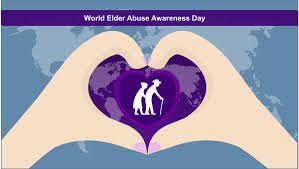June is Elder Abuse Awareness Month. To look into this, I went to the National Center on Elder Abuse website to learn more to share with you all today.
1 in 10 adults aged 60+ in the U.S. experienced some form of abuse in the prior year. Be alert for you and your loved ones.

What is Elder Abuse?
Elder abuse is any intentional or negligent act by a caregiver or a trusted person that causes or creates a serious risk of harm to an older adult. As defined by the Centers for Disease Control and Prevention, elder abuse “is an intentional act or failure to act that causes or creates a risk of harm to an older adult. An older adult is someone age 60 or older. The abuse often occurs at the hands of a caregiver or a person the elder trusts.”
The Elder Justice Act defines elder abuse as the knowing infliction of physical or psychological harm or the knowing deprivation of goods or services that are necessary to meet essential needs or to avoid physical or psychological harm. “Elder” means an individual age 60 or older.
All 50 states have some form of elder abuse prevention laws. Laws and definitions of elder abuse vary by state. State statutes are accessible through this link.
What are the Types of Elder Abuse?
Elder mistreatment typically takes one of the following forms: physical abuse, psychological or emotional abuse, sexual abuse, financial abuse, and neglect. Older adults may also experience maltreatment in the form of self-neglect and/or abandonment. The types of abuse are defined below.
Note: Definitions of maltreatment align with federal statutes, when applicable. Where statutory authority is unavailable, definitions derive from research in the field of elder abuse.

Physical Abuse:
The intentional or reckless use of physical harm or physical coercion that may result in bodily injury, physical pain, or impairment. Under the Older Americans Act, ‘‘physical harm’’ means bodily injury, impairment, or disease.
Examples include but are not limited to:
- Hitting, beating, pushing, shaking, slapping, kicking, pinching, and burning
- Unlawful, excessive, or unnecessary use of force like restraints or force-feeding
- Over-medication or under-medication

Sexual Abuse:
non-consensual sexual contact of any kind with an older adult.
Examples include but are not limited to:
- Unwanted touching, sexual assault or battery, sexual harassment
- Sexual interaction with elders who lack the capacity to give consent

Emotional / Psychological Abuse:
the infliction of anguish, pain, or distress through verbal or nonverbal acts.
Examples include but are not limited to:
- Verbal assaults, insults, threats, intimidation, humiliation, isolation, and harassment

Neglect:
the refusal or failure of a caregiver or fiduciary to fulfill any part of a person’s obligations or duties of care to an older person. The Elder Justice Act defines neglect as “the failure of a caregiver or fiduciary to provide the goods or services that are necessary to maintain the health or safety of an elder.
Examples include but are not limited to:
- Failing to provide for life necessities such as food, water, clothing, shelter, and medicine

Financial:
the illegal, unauthorized, or improper use of an older person’s resources for monetary or personal benefit, profit, or gain, or that results in depriving an older person of rightful access to, or use of, benefits, resources, belongings, or assets.
Examples include but are not limited to:
- Misusing or stealing an older person’s money or possessions
- Coercing or deceiving an older person into signing any document such as a contract or will
- Improper use of conservatorship, guardianship, or power of attorney
*Fraud and scams are characterized by acts perpetrated by a stranger or someone outside of a trust relationship. Deceit or misrepresentation are used to convince another to relinquish their money, property, or assets.

Self-Neglect:
an adult’s inability, due to physical or mental impairment or diminished capacity, to perform essential self-care tasks.
Examples include but are not limited to:
- Obtaining adequate food, water, clothing, shelter, personal hygiene, medical and mental health care, and safety precautions, and/or managing one’s finances.
- Self-neglect excludes a situation in which a mentally competent older person, who understands the consequences of their decisions, makes a conscious and voluntary decision to engage in acts that threaten their health or safety as a matter of personal choice.

Abandonment:
the desertion of an older person by an individual who has assumed responsibility for providing care for an elder, or by a person with physical custody of an elder.
A few state statutes classify abandonment as a separate and unique form of elder abuse. Definitions vary by state. Some state statutes categorize elder abandonment as a type of elder neglect. Abandonment may occur at a hospital, nursing home, or other public place.
What are Some Characteristics Associated with Elder Abuse?
Elder abuse can happen to anyone by anyone and occur in multiple settings, including the community and in long-term care facilities. A combination of medical, psychological, functional, social, and economic factors may be associated with the occurrence of elder maltreatment. These risk factors may potentially expose older adults to a heightened risk of abuse. Examples include but are not limited to:
- Chronic medical and mental health conditions
- Cognitive impairment
- Physical, financial, and emotional dependence
- History of poor family relationship between older adult and caregiver
- Caregiver burden
- Social isolation
- Lack of access to support and resources
Report Abuse
If you suspect someone is in immediate danger, call 911 (request a well check). You can report abuse in your community by contacting Adult Protective Services. Any suspected abuse in a nursing home, assisted living, or board and care facility to your state licensing agency.
Find local reporting resources HERE. Find information from The Center for Elder Justice and Education HERE
Tough Topics
I must admit, this is a tough topic to talk about. Realizing that much of what I talk about can be tough, I’d like to thank you for reading and sending me comments.
Count me in as a 2nd set of eyes and ears. Reach out via Email or Message me if you have any questions. For additional information about my work check out @ The Living Planner or @ The Living Planner.
To consider some things to consider earlier vs. later, my book The Living Planner (What to Prepare Now While You Are Living) is a resource for you. Here is a direct link to my shopping cart. Check it out HERE . For those who prefer to access information via an online portal, I’ve created a step-by-step 12-Module DIY method: Check it out HERE.
This quote from Helen Keller spoke to me this week. “Alone we can do so little; together we can do so much.” ❣️ Lynn
#Can’tPredictCanPrepare #PlanfortheUnplanned
